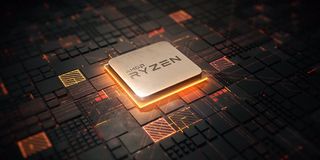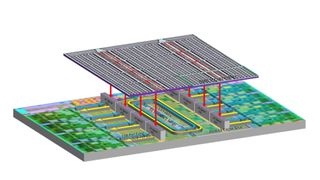AMD talks about its upcoming 3D V-Cache design at ISSCC
Those AMD boffins are doing some good work.

AMD has teased its 3D V-Cache technology for several months, culminating in the reveal of the Ryzen 7 5800X3D at the company’s CES 2022 keynote back in early January. Fast forward to today, and AMD has revealed some further technical details behind its design at the International Solid-State Circuits Conference (via Hardwareluxx).
The AMD Ryzen 7 5800X3D is set to be the first consumer-level processor to include an additional stacked cache. It's bleeding edge stuff.
Each Zen 3 chiplet contains 32MB of L3 cache which is shared among all of the eight on-die cores. During the planning phase of Zen 3, AMD designed it so that extra cache could be stacked without a fundamental redesign, not unlike building a single story house with the structural integrity to add a second story relatively simply.
A Zen 3 chiplet with its integrated 32MB of L3 cache can be expanded up to 96MB, by adding 64MB of stacked SRAM. The stacked cache chip measures just 41mm² and is attached via copper bonding, therefore skipping the more complicated step of requiring soldering.

The 3D V-Cache is made up of multiple 8 MB "slices" with 1024 contact points for each slice. Eight such slices mean there are 8192 contact points between the V-Cache and the underlying CCD. This delivers a bandwidth of beyond 2 TB/s which is partucularly impressive given the cache is not on the die itself.
AMD has had to tweak the underlying chiplets in order to fit the extra Z height inside the same form factor as a regular 5000 series CPU. AMD has also had to thin the CCDs and make tweaks to cater for the increased thermal dissipation that's to be expected from a stacked design.

Best CPU for gaming: the top chips from Intel and AMD
Best graphics card: your perfect pixel-pusher awaits
Best SSD for gaming: get into the game ahead of the rest
Heat and TDP concerns are the main reason we’ll only be seeing a 5800X3D and not a 5900X3D or 5950X3D. AMD needs to keep the 5800X3D inside a 105W TDP (or 142W peak). Adding cache to the higher core count models would either break that number leading to integration issues, or require downclocking. AMD also says that an eight core CPU is the current gaming sweet spot, making the 5800X the natural choice to receive the V-Cache treatment.
PC Gamer Newsletter
Sign up to get the best content of the week, and great gaming deals, as picked by the editors.
According to AMD, that the extra L3 cache can deliver up to 15% more gaming performance than the base 5800X. That may be enough to see it pull ahead of a 12900K is some games, at least those that are sensitive to low latency cache. For all the technological wizardry inside the 580X3D, there's the possibility that it will end up being a low volume chip. We hope to get our eager hands on a 5800X3D when the time comes.

Chris' gaming experiences go back to the mid-nineties when he conned his parents into buying an 'educational PC' that was conveniently overpowered to play Doom and Tie Fighter. He developed a love of extreme overclocking that destroyed his savings despite the cheaper hardware on offer via his job at a PC store. To afford more LN2 he began moonlighting as a reviewer for VR-Zone before jumping the fence to work for MSI Australia. Since then, he's gone back to journalism, enthusiastically reviewing the latest and greatest components for PC & Tech Authority, PC Powerplay and currently Australian Personal Computer magazine and PC Gamer. Chris still puts far too many hours into Borderlands 3, always striving to become a more efficient killer.
Most Popular





